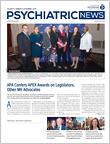New guidelines from The Joint Commission (TJC) regarding elimination of “ligature” suicide risks in psychiatric units are eliciting protests from psychiatric hospital administrators and others who say the standards are being imposed without sufficient public comment and without consistent standards for surveyors or for hospitals.
APA CEO and Medical Director Saul Levin, M.D., M.P.A., commented on the standards in his report to the APA Assembly last month, noting that some hospitals are being required to spend hundreds of thousands of dollars to replace doors and other hospital features that may appear to present a suicide risk. Such expenses could threaten the availability of psychiatric beds, he said
“While, of course, we agree with the need to minimize the risk of suicide, we as psychiatrists know that the risk cannot be eliminated,” he said. “The question becomes, how far are you able to go to eliminate risk? And what is the best way to do this?”
Levin told Assembly members that APA and other concerned organizations will be working with the TJC and the Centers for Medicare and Medicaid Services (CMS) to “ensure that the [standards] are not unduly burdensome or expensive.”
He noted after the meeting that key APA staff were scheduled to meet with CMS officials at press time. Also, APA representatives have been invited by CMS to join a stakeholder task force that will examine and develop standardized guidance on this issue and others impacting the treatment of patients with psychiatric conditions.
The issue came to the attention of APA staff earlier this year when APA members began reporting that their facilities were being cited for ligature risks. In some cases, members said surveyors recommended changes that were not feasible and that ignored physical barriers and prohibitive costs as well as other competing or conflicting patient safety regulations.
There appears to have been no formal notification of the standards regarding ligature risk other than a March 1 article appearing in the TJC’s weekly newsletter stating that CMS would “place added emphasis on assessment of ligature, suicide, and self-harm observations in psychiatric hospitals and inpatient psychiatric patient areas in general hospitals.”
Since then, TJC accreditation surveyors have been assigned the responsibility of including assessment for ligature or self-harm risks, as well as documenting each facility’s mitigation plans and policies to reduce these risks. This is done as part of the in-person survey for the TJC hospital accreditation program and to measure compliance with the CMS Hospital Conditions of Participation for participation in the Medicare and Medicaid programs.
Among the frequently asked questions posted on the TJC website about its standards is the following, “What are The Joint Commission expectations for identifying and managing ligature risks in the hospital setting?”
The answer includes the following: “All physical risks not required for the treatment of the patient that can be removed, must be removed. Furthermore, an appropriate level of effective surveillance must be implemented if self-harm risks remain in the environment. Organizational policies and procedures must adequately guide staff in the assessment of patients’ risk for suicide/self-harm and the implementation of interventions based upon the patients’ individual needs.”
APA staff working with CMS and the TJC said that in July the TJC had formed a “technical expert panel” to determine existing evidence-based standards to reduce ligature or self-harm risks in inpatient psychiatric settings. During two meetings, the panel determined that very limited evidence exists to inform standard/objective guidance for surveyors to follow when reviewing ligature risks during site visits.
The APA Assembly is also concerned about the issue. At its November meeting in Washington, D.C., the Assembly approved an action paper that calls on APA to “immediately request that CMS and The Joint Commission delay implementation of these new and ligature risk standards” and to request that CMS include representatives from APA, the American Hospital Association, the AMA, and other appropriate stakeholders in its assessment of ligature risks and development of appropriate accreditation standards. The action paper does not become policy unless the Board of Trustees approves it. The paper will come before the Board at its meeting this month.
“Usually there is a period of input from stakeholders, but what happened here was an anomaly,” said Seeth Vivek, M.D., Area 2 representative, who was a co-sponsor of the action paper. “In practice, The Joint Commission began to implement these standards requiring hospitals to be as close to ligature free as possible though the standards had not been circulated [for comment and review].”
Phillip Scuria, M.D., Area 5 representative, is affiliated with a hospital in Vicksburg, Miss., that has a small psychiatric unit. Doorknobs that were considered a suicide risk had to be replaced at a cost of $800 each, he said. “Small units will be forced to close down because of this,” he said.
Jeffrey Borenstein, M.D., also a co-sponsor of the Assembly action paper and editor in chief of Psychiatric News, concurred. “This is important and timely,” Borenstein said at the Assembly meeting. “We don’t have enough psychiatric beds as it is, and this will result in the closing of psychiatric units.” ■
The Joint Commission Standards FAQ on ligature risks is posted
here.

